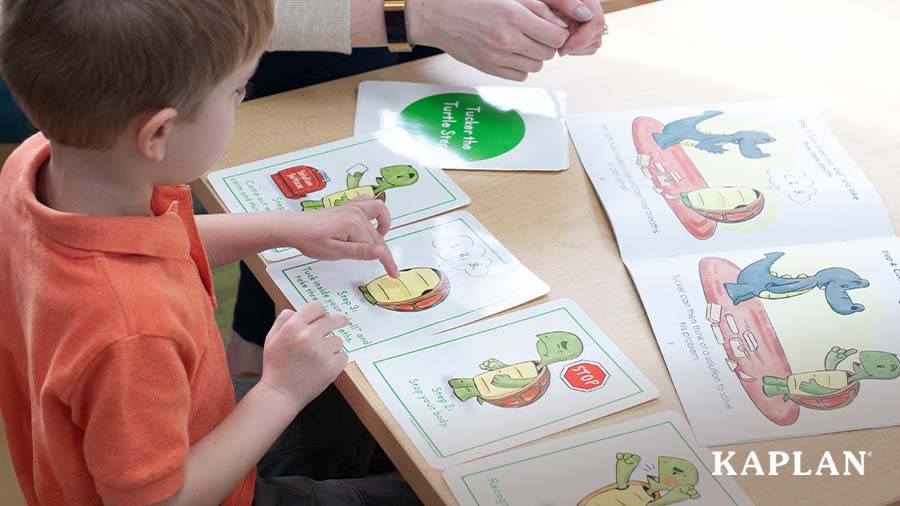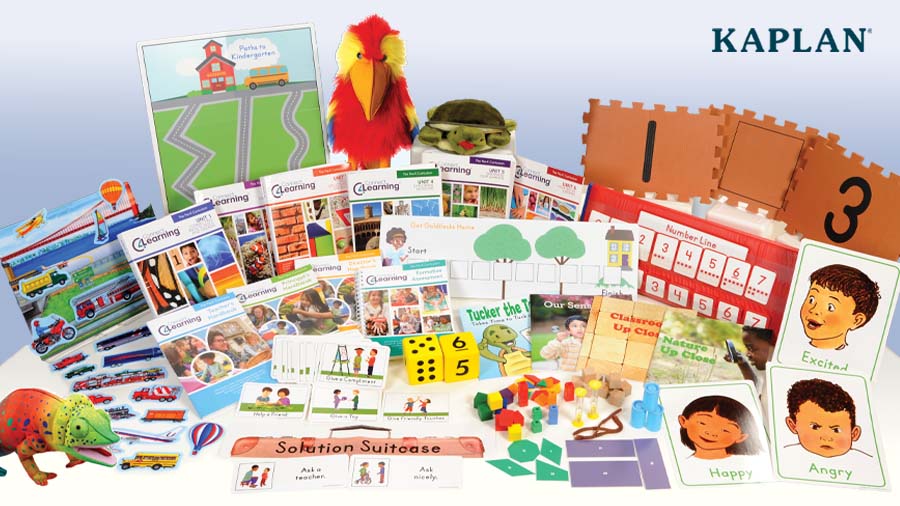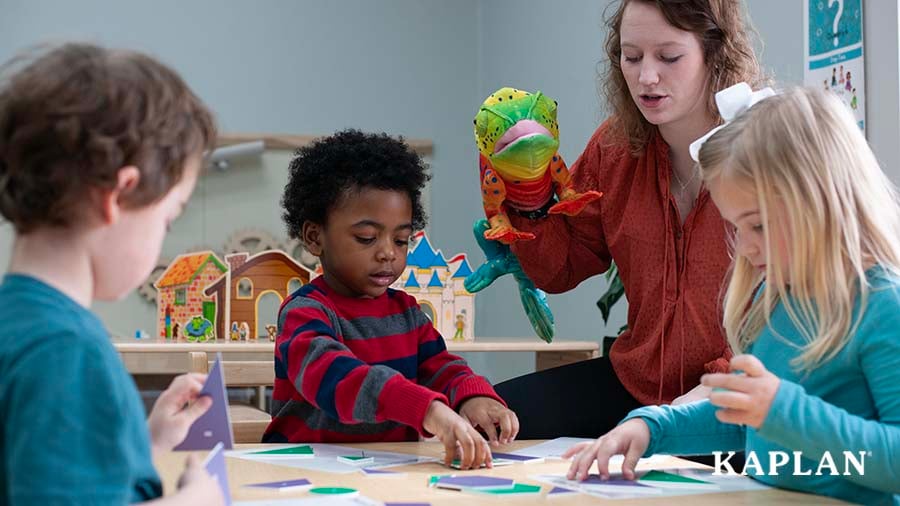Prekindergarten education plays a significant role in the development and academic success of young children. It is important that any pre-kindergarten (or pre-K) curriculum focuses on literacy, social-emotional development, math, and science so that children receive a solid foundation from the start.
Given the vast majority of curriculum options available today, few, if any, weave together these four domains of early learning seamlessly. As a result, children are entering kindergarten with lower school readiness scores, especially those in under-resourced programs with limited exposure to these concepts.
A team of nationally recognized early childhood experts set out to close this gap by creating the Connect4Learning Pre-K Curriculum®. This interdisciplinary early childhood prekindergarten curriculum synthesizes learning across all learning domains with an emphasis on mathematics, science, literacy, and social-emotional development.
If you are considering a new prekindergarten curriculum for your school or district, you likely have questions and concerns that you hope to address before making your final decision. We want you to feel confident you are making the best choice possible, which is why we created this Connect4Learning buying guide. Continue reading to find answers to your questions and discover how this curriculum meets the developmental and educational needs of young children.

What is the Connect4Learning Curriculum, and how was it developed?
Despite our hard work, the United States still falls behind other developed countries in math, science, and literacy proficiency. That gap is even wider for children in under-resourced communities.
A team of nationally recognized early childhood experts set out to close this gap by aligning early childhood research to create a fun and developmentally appropriate pre-k curriculum, Connect4Learning. The National Science Foundation provided funding and support for the team of experts to conduct their research for this curriculum.
The experts who created Connect4Learning: Julie Sarama, PhD; Kimberly Brenneman, PhD; Douglas H. Clements, PhD; Nell K. Duke, EdD; and Mary Louise Hemmeter, PhD.
What instructional approach does Connect4Learning follow?
The Connect4Learning curriculum follows an interdisciplinary approach, seamlessly weaving learning and teaching across the four domains: literacy, mathematics, science, and social-emotional development. It also provides a rigorous scope and sequence that propels the learning and development of four-year-old children.
The researchers took a strategic approach when creating the instructional framework of Connect4Learning. Lessons will begin with math and then incorporate meaningful connections to science. These same lessons will also include language and literacy components and strategies to enhance social-emotional development.
For example, during the "Garden Party" in unit 5, children use math skills to count seeds and create a mural with various shapes. Science skills emerge as children learn about plants and how they grow. Children use their early literacy skills to write invitations for the garden party and read books about gardening and plant growth. Finally, children build positive social and emotional skills as they learn to work alongside peers and solve problems.
All lessons portray a high level of authenticity to help children connect to their daily lives. In addition, this curriculum promotes experiences in which children's thinking moves over time from the simple to the complex and from concrete to abstract.
Will Connect4Learning meet my state's early learning guidelines?
Connect4Learning does meet the criteria for high-quality curricular materials for a vast majority of states in the US. It also meets the educational guidelines and learning outcomes for Head Start and private pre-k programs. Keep reading to see how it meets this criteria.
How does Connect4Learning support child development?
The Connect4Learning curriculum incorporates goals and objectives that are developmentally appropriate for prekindergarten children. It brings math and science to the forefront to support the development of ten comprehensive thinking processes critical to children's cognitive development. These processes are:- Cooperating
- Comparing and Classifying
- Communicating and Representing
- Reasoning and Problem Solving
- Observing
- Using Tools Strategically
- Making Sense
- Persisting, Attending, and Self-Regulation
- Curiosity
- Creating, Imaging, and Innovating
Why are mathematics and science a feature of the Connect4Learning curriculum? Because these domains predict later school success and are fundamental to children's cognition and learning.
Throughout the curriculum, teachers will receive guidance to ask open-ended questions, support child creativity, and offer activities and spaces where children can investigate and explore. Children will have opportunities to think and play imaginatively, which paves the way for flexible thinking and problem-solving.

How does Connect4Learning promote the development of early literacy and language?
The Connect4Learning curriculum also addresses a range of literacy skills in developmentally appropriate ways through an approach we call authentic literacy. Authentic literacy means children engage in reading and writing for the same reasons people do outside of school.
With adult support, children will engage in activities such as writing invitations for classroom events or reading through instructions that show them how to make snacks for snack time. Authentic literacy instills a deep understanding of print and how we use it while motivating children to engage with the print they see around them daily.
Connect4Learning weaves language throughout the curriculum, and we draw on research to inform our approach to phonological awareness, alphabet knowledge, and the order in which we teach alphabet letters. The vocabulary you will find in Connect4Learning comes from each domain and the vocabulary that specific domain suggests children know.
For example, the science domain may want children to know words like build, construct, and design in a particular unit. The math domain may want children to know vocabulary like "rectangular prism" in another unit. Children will encounter these words several times during read-aloud and group activities. Teachers can use visual cue cards to revisit the words during class discussions and help children grow their vocabulary.
How does Connect4Learning meet the diverse learning needs of all children?
The interdisciplinary approach of Connect4Learning includes a variety of instructional methods that appeal to various learning interests and needs. The curriculum support materials provide extensions to maximize student learning for children with varying abilities, such as those who need visual cues for comprehension. Each lesson within the curriculum also gives teachers suggestions to modify activities based on the needs of individual children.
Equity and the importance of allowing children to speak and feel heard are at the core of Connect4Learning. Many pre-K settings that serve children of low socioeconomic status or children of color have fewer opportunities for children to develop math skills or gain exposure to concepts like science and engineering. Sometimes, these pre-K settings have lower expectations for what children are capable of.
Connect4Learning counters those ideas by bringing pre-K classrooms throughout the United States a rich curriculum that maintains high expectations for all learners.
Throughout each unit, lessons encourage community involvement that positions children as capable, powerful, and important members of society.
How does Connect4Learning support instruction for Dual Language Learners?
The Connect4Learning curriculum supports all learners, including those with a home language other than English. It emphasizes skills that are not language-dependent but universal to learning and healthy development so that dual-language learners can thrive both socially and academically.
Connect4Learning also facilitates oral-language development by promoting learning through play by implementing engaging learning centers and project-based learning. Active participation in learning centers helps dual-language learners engage in conversations as they play with other children, express their imaginations, and solve problems using their developing English.
The Teacher's Handbook provides clear direction for supporting dual-language learners in their home language and English.
How does Connect4Learning embrace and promote play?
In a full-day Connect4Learning classroom, at least 50% of the daily schedule consists of learning center time and free play. Learning centers provide a variety of ways for children to engage in independent and small group activities that facilitate peer-to-peer social interactions. These child-directed experiences foster higher levels of thinking, problem-solving skills, and cooperation.
Another vital aspect of Connect4Learning is unit projects. Working on projects over a period of weeks can be exciting for children, fostering their cognitive development, sense of accomplishment, and self-regulation. At the end of each unit, children can share their completed project with other classes, their families, and the community.
How does Connect4Learning promote regular family communication?
Effective family engagement and positive family/school partnerships are important facets of Connect4Learning. The curriculum includes newsletter templates teachers can send home when communicating with families about upcoming classroom lessons and child performance. The online portal allows families to access children's assessments and computer math activities that children can play outside their regular school day.
When classrooms establish respectful family relationships at the beginning of the school year, teachers are more effective in their role inside the classroom, and children can better meet their learning outcomes.

What is included in the Connect4Learning kit?
Connect4Learning is a rich pre-k curriculum designed with public pre-k in mind. This kit features 32 weeks of interdisciplinary lesson plans and learning center activities for up to 15 students. It is available as an English or Spanish program.
View more details about each component in the Connect4Learning curriculum below:
Welcome Box
The Welcome Box includes a teacher's handbook and six unit manuals outlining 32 weeks of lessons and learning center activities. We suggest reading the teacher's handbook from cover to cover to become familiar with:- The concepts and research embedded in the Connect4Learning curriculum
- The teacher's interactive role during lessons and learning centers
- Resources to help engage families in their children's learning
- Sample daily schedules to help plan for full-day and half-day pre-k programs
If you purchase the Spanish version of Connect4Learning, your Welcome Box will come with the Spanish versions of the teacher's handbook and six unit manuals.
Unit Guides
The manuals for Units 1-5 each outline six weeks of vocabulary, learning objectives, material plans, and daily lessons and activities. Unit 6 is only two weeks long. Each unit manual starts with an overview of highlights for that unit and each week of lessons. These manuals also:- Suggest daily routines and transitions for the children in your pre-k classroom
- Outline learning center objectives and activities
- Provide ways to engage families and the community in each weekly lesson
Inside your Connect4Learning kit, you will find these unit manuals:
Unit 1 - Connecting with School and Friends. This unit builds the most essential school connections – those among the child, peers, teachers, and the school. Children will learn classroom routines and how to use classroom materials. They will also start building foundations in mathematics, social-emotional development, and literacy.
Unit 2 - Our Environment. In this unit, children begin investigating outdoor environments, including the areas around their school and the coral reef. Lessons, activities, and books support this focus as children learn how animals, plants, and the earth's features are connected.
Unit 3 - How Structures Are Built. This unit focuses on how structures and tools work, allowing children to become creative doers and thinkers. They will explore the form and function of objects through observations, simple experiments, games, and activities.
Unit 4 - Exploring Museums. This unit centers on museums, including what they are, what you will find inside them, and how they work in a community. Children will learn about paleontology and medieval times, but teachers may also focus on their favorite museum-themed topics. During Unit 4, children will create a classroom museum that friends and family can visit.
Unit 5 - Growing Our Garden. In this unit, children will investigate gardens, how they grow, and the living things within them. Science will play a significant role in this unit as children learn about plant life cycles, the benefits of gardens, and the ways food sustains life.
Unit 6 - How We've Grown. The final unit allows the children to look back at how much they have learned and grown throughout the last year. They will revisit some of their favorite books, games, and activities as they prepare for the next step in their educational journey – kindergarten!
Connect4Learning Formative Assessment
Teachers' most insightful observations usually occur during small group activities and one-on-one instruction. Connect4Learning incorporates formative assessment checkpoints as a part of daily small-group lessons. As the teacher completes a lesson, they will mark each child's ability for the core objectives addressed in that lesson. This information will help teachers support or challenge children's learning.This curriculum supports formative assessments by providing:
- Guidance on the skills to observe and questions teachers can ask to elicit children's understanding of concepts
- An assessment book and online portal where teachers can record observations to watch how students grow and share their findings with families
- Strategies for individualized learning to help children meet achievement outcomes

Classroom Visuals
The Large Card Set includes dozens of custom-made visual aids for teachers to use while implementing lessons. Please note that these are not flashcards. Instead, they serve as a visual aid for your classroom, learning centers, and group lessons. Some of the cards you will find in your Connect4Learning kit include:- Alphabet cards and embedded alphabet cards that help children with letter recognition and early literacy
- Number cards and number dot cards that help children with number recognition and counting
- Emotion cards, expectation cards, and friendship skills cards that help children visualize their emotions and learn appropriate classroom behaviors
- Informational cards to use during small group activities that support children as they complete art projects, create a classroom museum, grow seeds, etc.
The classroom visuals will arrive in a sturdy storage container with separation tabs to help you quickly organize and find these classroom aids. If you purchase the Spanish version of Connect4Learning, these visuals will come in Spanish and English.
Classroom Materials Tubs
The Connect4Learning kit includes two classroom materials tubs. Each tub includes specific items a teacher will need to implement the curriculum in their classroom. Tub one contains playful puppets, pocket charts, small classroom visuals, math manipulatives, felt sets, and more. Tub two contains the Connect4Learning foam number/shape mat, approximately 20 custom books, and seven classroom-tested games.
In the Spanish version of Connect4Learning, all custom books will come in English and Spanish.
Trade Books
The trade book collection, comprising approximately 100 titles, includes nonfiction works, how-to books, and fiction titles that teachers can use during daily read-aloud. Most of the books in your Connect4Learning kit closely connect to the STEM focus within each unit. Some of these books also feature people of various backgrounds so that all children feel connected to the stories and represented in the classroom.
Consumables Pack
The consumables pack includes materials you will need to replenish each year after your initial implementation. These materials include a formative assessment book, three sticker sets, science journals for the entire class, and solution suitcase student pads.
Classroom Poster Set
Connect4Learning also includes nine custom classroom posters that provide visual cues and reinforce learning. These cards feature the alphabet, problem-solving steps, feelings, and more. The Spanish version of this curriculum includes these posters in both Spanish and English.
Principal's Handbook
The principal's handbook offers school administrators information and guidance to support the implementation of Connect4Learning in public school pre-k programs. This handbook includes information on educational best practices, the importance of play, and other important concepts and instructional techniques you will find inside Connect4Learning.
Online Portal Access
The online portal serves as an invaluable digital classroom management tool. It works on desktops and laptops, providing teachers flexible access to the unit lesson plans and activities so they can plan for the week, whether at school or home.
Teachers can also use this portal to record formative assessment observations digitally and upload samples of children's work over the course of the school year. Families can access portions of the online portal to view teacher notes about what the class is learning and see photos of their child's classroom explorations. They can also access games in the online portal that their child can play at home.
Which Connect4Learning subscription is best?
When you purchase your Connect4Learning kit, you can choose from either a one-, four-, or eight-year subscription to our online portal.
It may take time to implement a new curriculum and see student results. We recommend subscribing to either a four-year or eight-year Connect4Learning online portal subscription in the beginning so that you have enough time to implement the new material, evaluate student performance, and determine if this curriculum meets your expectations and goals. The four- and eight-year subscriptions also come with a slight price adjustment and may be a more affordable option for your district in the long run.
No matter which subscription you purchase, you must replenish your consumable products annually.
How much can I expect to invest in the Connect4Learning curriculum?
As you research curricula options, you want to ensure you are choosing options that fit your assigned budget. The English version of Connect4Learning requires an investment of approximately $3000 per classroom kit. The Spanish version, which includes additional trade books and classroom visuals to support dual languages, requires an investment of approximately $3300 per classroom kit.
The Connect4Learning curriculum team also provides professional learning opportunities to help you implement this curriculum with fidelity. You can read about those options and their potential investment below.
How can I implement Connect4Learning with fidelity?
Kaplan Early Learning Company offers a variety of training opportunities to help administrators and educators implement Connect4Learning with fidelity. These opportunities are delivered virtually or in person and are not included in your Connect4Learning curriculum kit.
After purchasing your Connect4Learning kits, you can enroll in implementation training to help you and your staff better understand the curriculum components and how best to use them in the classroom. You can expect to invest approximately $90 per person for virtual implementation sessions and approximately $120 per person for in-person implementation sessions. These sessions require a minimum booking of 30 attendee slots.
Following your initial implementation training, we recommend a series of virtual follow-up sessions to support child-teacher relationships and connections throughout each unit of study. Pricing for these sessions varies based on topic, number of participants, and the delivery method. You can expect to invest around $45 + per person for each follow-up session. Again, these sessions require a minimum booking of 30 attendee slots.
To request a schedule of upcoming professional development and implementation sessions, click here.
Ready to bring Connect4Learning into your classrooms?
Our Connect4Learning specialists will happily work with you to answer any questions you may have about Connect4Learning and how it will improve learning outcomes in your district. They will also be happy to help you choose professional development training sessions for your educators and staff so they can better support and educate the children in their care.

